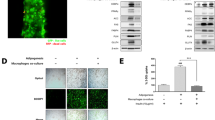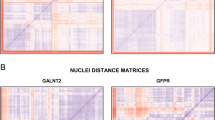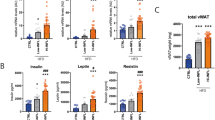Abstract
Recent studies have suggested that macrophages were integrated into adipose tissues to interact with adipocytes, thereby exacerbating inflammatory responses. Furthermore, both adipocytes and macrophages appear to express toll-like receptor-4 (TLR-4), and free fatty acids may stimulate cells through TLR-4. Herein, we analyzed genes differentially expressed in adipocytes when co-cultured with macrophages in the presence of a ligand for TLR-4, bacterial lipopolysaccharide (LPS). RAW264.7, a murine macrophage cell line and differentiated 3T3-L1 adipocytes were co-cultured using a transwell system. Genes differentially expressed in adipocytes were analyzed by the DNA microarray method following 4, 8, 12 and 24 h stimulation with 1 ng ml−1 of Escherichia coli LPS. Randomly selected genes with high expressions were confirmed by quantitative methods at both the gene and the protein level. Co-culture of macrophages and adipocytes with a low LPS concentration (1 ng ml−1) markedly upregulated gene expressions associated with inflammation and/or angiogenesis, such as those of interleukin-6 (IL-6), MCP-1, RANTES and CXCL1/KC, in adipocytes. Furthermore, several genes associated with insulin resistance were differentially expressed. Upregulations of genes encoding MCP-1, RANTES and CXC/KC were confirmed by quantitative methods. These results suggest that ligands for TLR-4 stimulate both adipocytes and macrophages to upregulate the expressions of many genes associated with inflammation and/or angiogenesis.
This is a preview of subscription content, access via your institution
Access options
Subscribe to this journal
Receive 12 print issues and online access
$259.00 per year
only $21.58 per issue
Buy this article
- Purchase on Springer Link
- Instant access to full article PDF
Prices may be subject to local taxes which are calculated during checkout


Similar content being viewed by others
References
Pradhan AD, Manson JE, Rifai N, Buring JE, Ridker PM . C-reactive protein, interleukin 6, and risk of developing type 2 diabetes mellitus. JAMA 2001; 286: 327–334.
Ridker PM, Cushman M, Stampfer MJ, Tracy RP, Hennekens CH . Inflammation, aspirin, and the risk of cardiovascular disease in apparently healthy men. N Engl J Med 1997; 336: 973–979.
Yudkin JS, Kumari M, Humphries SE, Mohamed-Ali V . Inflammation, obesity, stress and coronary heart disease: is interleukin-6 the link? Atherosclerosis 2000; 148: 209–214.
Xu H, Barnes GT, Yang Q, Tan G, Yang D, Chou CJ et al. Chronic inflammation in fat plays a crucial role in the development of obesity-related insulin resistance. J Clin Invest 2003; 112: 1821–1830.
Weisberg SP, McCann D, Desai M, Rosenbaum M, Leibel RL, Ferrante Jr AW . Obesiy is associated with macrophage accumulation in adipose tissue. J Clin Invest 2003; 112: 1796–1808.
Suganami T, Nishida J, Ogawa Y . A paracrine loop between adipocytes and macrophages aggravates inflammatory changes: role of free fatty acids and tumor necrosis factor alpha. Arterioscler Thromb Vasc Biol 2005; 25: 2062–2068.
Lin Y, Lee H, Berg AH, Lisanti MP, Shapiro L, Scherer PE . The lipopolysaccharide-activated toll-like receptor (TLR)-4 induces synthesis of the closely related receptor TLR-2 in adipocytes. J Biol Chem 2000; 275: 24255–24263.
Shi H, Kokoeva MV, Inouye K, Tzameli I, Yin H, Flier JS . TLR4 links innate immunity and fatty acid-induced insulin resistance. J Clin Invest 2006; 116: 3015–3025.
Yamashita A, Soga Y, Iwamoto Y, Yoshizawa S, Iwata H, Kokeguchi S et al. Macrophage–adipocyte interaction: marked IL-6 production by co-cultures stimulated with LPS. Obesity 2007; 15: 2549–2552.
Lumenig CN, Bodzin JL, Saltiel AR . Obesity induces a phenotype switch in adipose tissue macrophage polarization. J Clin Invest 2007; 117: 175–184.
Rotter V, Nagaev I, Smith U . Interleukin-6 (IL-6) induces insulin resistance in 3T3-L1 adipocytes and is, like Il-8 and tumor necrosis factor-alpha, overexpressed in human fat cells from insulin-resistant subjects. J Biol Chem 2003; 278: 45777–45784.
Kamei N, Tobe K, Suzuki R, Ohsugi M, Watanabe T, Kubota N et al. Overexpression of monocyte chemoattractant protein-1 in adipose tissue causes macrophage recruitment and insulin resistance. J Biol Chem 2006; 281: 26602–26614.
Cigolini M, Tonoli M, Borgato L, Frigotto L, Manzato F, Zeminian S et al. Expression of plasminogen activator inhibitor-1 in human adipose tissue: a role for TNF-alpha? Atherosclerosis 1999; 143: 81–90.
Kim CS, Park HS, Kawada T, Kim JH, Lim D, Hubbard NE et al. Circulating levels of MCP-1 and IL-8 are elevated in human obese subjects and associated with obesity-related parameters. Int J Obes 2006; 30: 1347–1355.
Yang RZ, Lee MJ, Hu H, Pollin TI, Ryan AS, Nicklas BJ et al. Acute-phase serum amyloid A: an inflammatory adipokine and potential link between obesity and its metabolic complications. PLoS Med 2006; 3: e287.
Huber J, Kiefer FW, Zeyda M, Ludvik B, Silberhumer GR, Prager G et al. CC chemokine and CC chemokine receptor profiles in visceral and subcutaneous adipose tissue are altered in human obesity. J Clin Endocrinol Metab 2008; 93: 3215–3221.
Ueki K, Kondo T, Tseng YH, Kahn CR . Central role of suppressor of cytokine signaling proteins in hepatic steatosis, insulin resistance, and the metabolic syndrome in the mouse. Proc Natl Acad Sci USA 2004; 101: 10422–10427.
Russell AP . PGC-1 alpha and exercise: important partners in combating insulin resistance. Curr Diabetes Rev 2005; 1: 175–181.
Salcedo R, Ponce ML, Young HA, Wasserman K, Ward JM, Kleinman HK et al. Human endothelial cells express CCR2 and respond to MCP-1: direct role of MCP-1 in angiogenesis and tumor progression. Blood 2000; 96: 34–40.
Charo IF, Ransohoff RM . The many roles of chemokines and chemokine receptors in inflammation. N Engl J Med 2006; 354: 610–621.
Acknowledgements
This study was supported, in part, by a Grant-in-Aid (no. 20659298) from the Japan Society for the Promotion of Science and from the Academic Frontier Project for Private Universities, matching fund subsidy from the Ministry of Education, Culture, Sports, Science and Technology, 2007–2011.
Author information
Authors and Affiliations
Corresponding author
Additional information
Supplementary Information accompanies the paper on International Journal of Obesity website (http://www.nature.com/ijo)
Supplementary information
Rights and permissions
About this article
Cite this article
Yamashita, A., Soga, Y., Iwamoto, Y. et al. DNA microarray analyses of genes expressed differentially in 3T3-L1 adipocytes co-cultured with murine macrophage cell line RAW264.7 in the presence of the toll-like receptor 4 ligand bacterial endotoxin. Int J Obes 32, 1725–1729 (2008). https://doi.org/10.1038/ijo.2008.153
Received:
Revised:
Accepted:
Published:
Issue Date:
DOI: https://doi.org/10.1038/ijo.2008.153
Keywords
This article is cited by
-
Effects of co-incubation of LPS-stimulated RAW 264.7 macrophages on leptin production by 3T3-L1 adipocytes: a method for co-incubating distinct adipose tissue cell lines
Bulletin of the National Research Centre (2022)
-
The Link Between Periodontal Inflammation and Obesity
Current Oral Health Reports (2021)
-
Ccr7 null mice are protected against diet-induced obesity via Ucp1 upregulation and enhanced energy expenditure
Nutrition & Metabolism (2019)
-
Dental pulp cell-derived powerful inducer of TNF-α comprises PKR containing stress granule rich microvesicles
Scientific Reports (2019)
-
The Influence of Periodontal Burden on Metabolic Control of Diabetes—Myth or Reality?—from a Nutritional Perspective
Current Oral Health Reports (2017)



